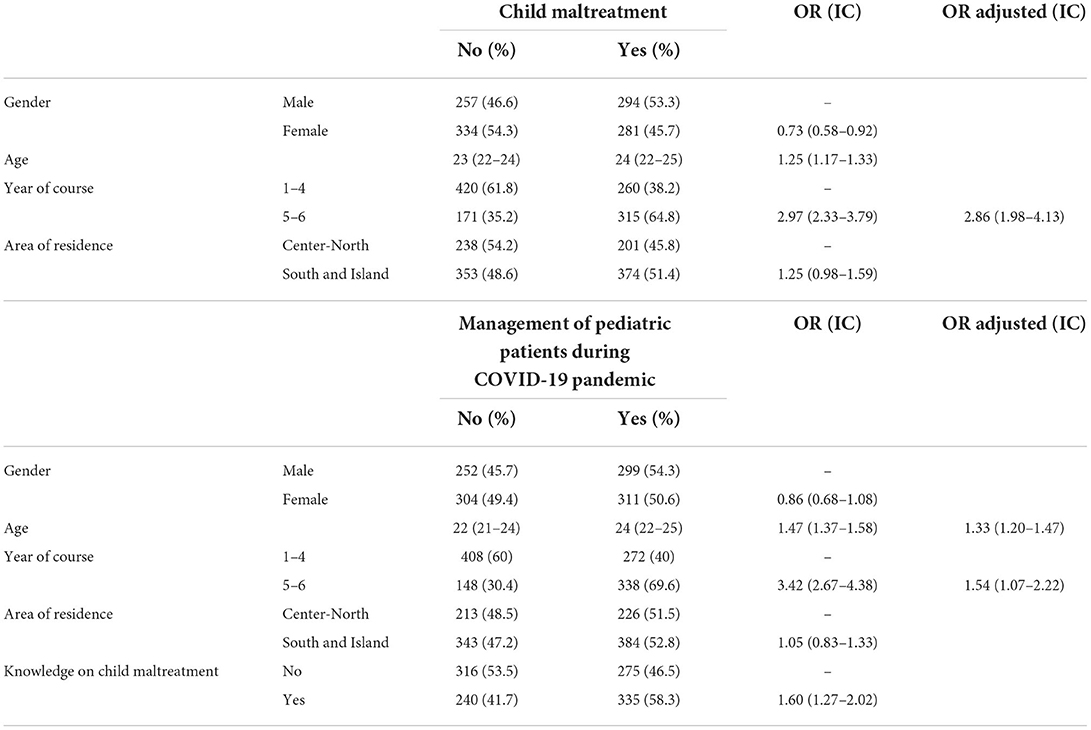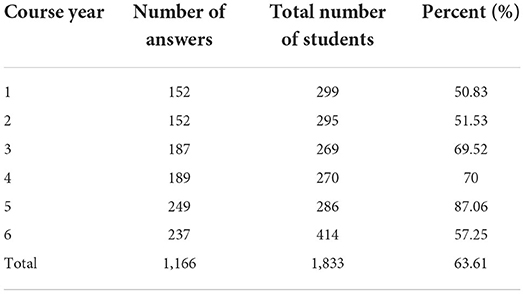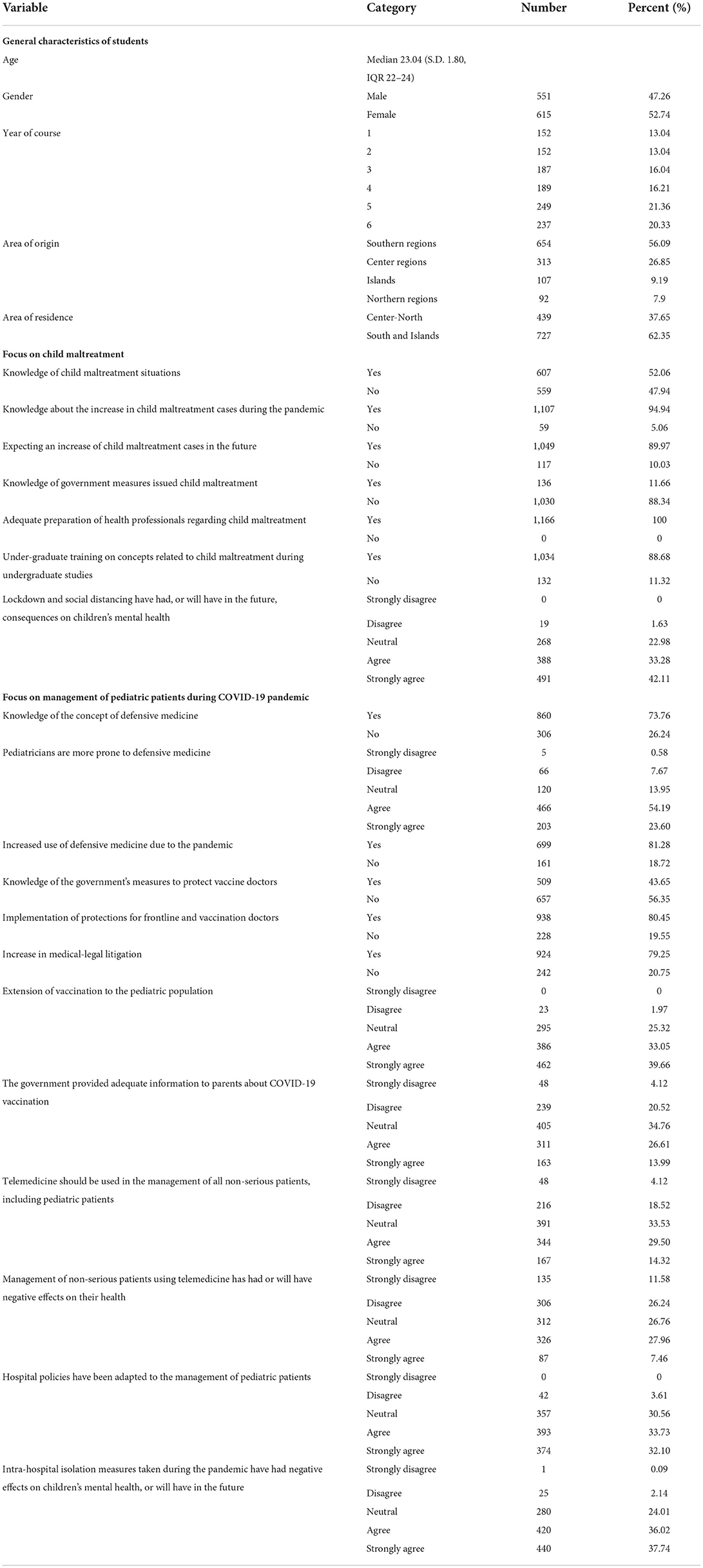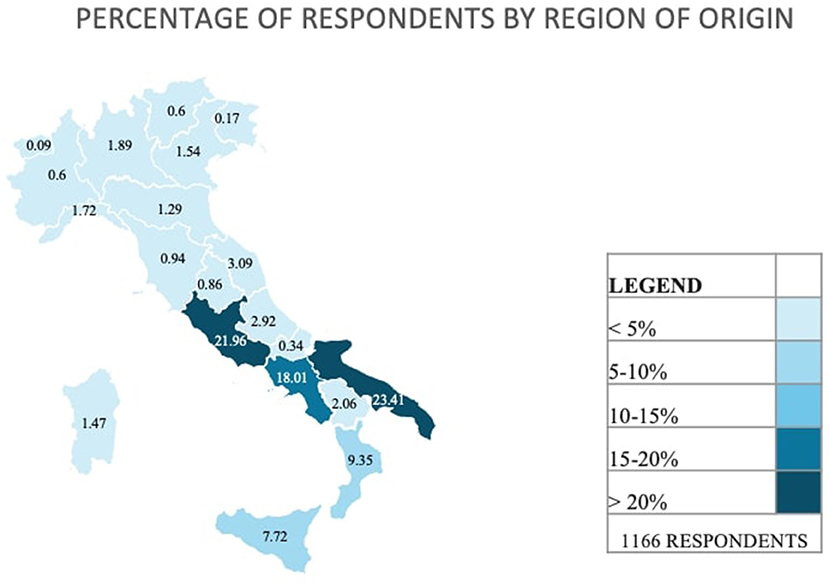- 1Department of Health Surveillance and Bioethics, Section of Legal Medicine, Fondazione Policlinico Universitario A. Gemelli IRCCS, Università Cattolica Del Sacro Cuore, Rome, Italy
- 2Section of Hygiene, University Department of Life Sciences and Public Health, Università Cattolica del Sacro Cuore, Rome, Italy
- 3Università Cattolica del Sacro Cuore, Fondazione Policlinico Universitario A. Gemelli IRCCS, Rome, Italy
- 4Department of Woman and Child Health and Public Health—Public Health Area, Fondazione Policlinico Universitario A. Gemelli IRCCS, Rome, Italy
- 5Unit of Obstetrics and Obstetric Pathology, Department of Woman and Child Health and Public Health, Fondazione Policlinico Universitario A. Gemelli IRCCS, Rome, Italy
Purpose of the study: To assess perception, awareness, and attitudes regarding the medico-legal relevance of child maltreatment and management of pediatric patients during the COVID-19 pandemic in a cohort of medicine and surgery students, with a particular focus on child safety and maltreatment.
Methods: A cross-sectional, web-based survey was conducted through an anonymous questionnaire on the personal websites of Università Cattolica del Sacro Cuore medical students.
Results: The study included 1,166 participants, the majority of whom were experienced with child maltreatment and defensive medicine; only a small percentage was aware of the government's efforts to prevent child maltreatment and safeguard vaccination physicians. Moreover, there was no agreement on the use of telemedicine for non-serious pediatric patients or on the consequences it might have on their health. Finally, the detrimental impacts of lockdown on children's mental health are a major worry.
Conclusions: Knowledge of these themes is mainly implemented by deepening these concepts during the undergraduate studies since a high level of knowledge on child maltreatment and on the management of COVID-19 pandemic was significantly associated with clinical years of course. Specific seminars analyzing telemedicine and legislative protections concerning minors and those concerning vaccination doctors should be included in the study plan to raise awareness these concepts.
Introduction
The first coronavirus disease (COVID-19) outbreak was announced at the end of December 2019 in Wuhan, China. The virus soon spread globally, and, for this reason, the World Health Organization declared a state of pandemic (1).
The first country that was affected in Europe was Italy. On January 31, 2020, the Italian government declared the state of emergency and established a number of measures aimed at limiting the spread of the virus.
The first nationwide lockdown was imposed on March 3, 2020, following the isolation of the first affected municipalities. Restrictions were implemented based on the regional spread of the virus until March 31, 2022 (2–4).
Many concerns have been raised about how these measures, particularly the lockdown, may affect the health, especially the mental health, of the most vulnerable individuals, including children.
Governments have taken steps to lessen the economic effects of the COVID-19 pandemic, but there has not been an adequate response to reduce domestic violence, child abuse and mental health deterioration (5). Added to this is the impact on the mental health of healthcare professionals who have been on the frontline during the pandemic and the constant risk of professional liability (6).
Doctors and medical and surgical students are probably ill-equipped to deal with the pandemic's effects on children's mental health and physician professional responsibility in the coming years.
For these reasons, the aim of this study was to assess how a cohort of medical students perceived, were aware of, and felt about the medico-legal relevance of these themes in the context of the COVID-19 pandemic, with a focus on child abuse and the treatment of pediatric patients.
Materials and methods
Study design and participants
A cross-sectional, web-based survey was conducted during May 2022, in the period immediately following the end of the State of Emergency. Through outlook form, an anonymous questionnaire was administered on the personal websites of medical students attending the undergraduate course at the Università Cattolica del Sacro Cuore. As this survey was addressed to medical students, the study was based on a non-probability, voluntary sample. Participation was voluntary and unpaid.
Questionnaire design
The questionnaire (see Supplementary File 1) consisted of various sections covering the following aspects: demographic data (gender, age, course year and region of origin), knowledge and awareness of child maltreatment and, finally, the aspects of patient management during the COVID-19 pandemic. In total, the questionnaire comprised 23 questions. Students were asked to answer the questions using both binary answers and a 5-point Likert scale.
Validation of the questionnaire
To further improve the study's quality, a two-step external validation process was used. First, a heterogeneous team of students and professors from various disciplines conducted cognitive pretesting on a small sample size of 8, and then a larger cohort of 50 medical students from the course of medicine and surgery underwent pilot testing (7, 8).
Statistical analyses
The reliability of the scales was measured using the Cronbach's alpha coefficient. Using 1,000 boot-strap samples, the 95% confidence interval (CI) for each alpha value was estimated. All variables were then subjected to descriptive analyses.
Using multivariable logistic regression models, factors of knowledge and awareness on the two issues of concern (management of the COVID-19 pandemic and child abuse) were analyzed. The two tiers of the two demographic variables—region of residence and year of course—were combined from the original numerous categories.
Regions were recoded into Center-North and South and Islands and year of course was recoded into preclinical years (1–4) and clinical ones (5 and 6). Respondents were judged to have a high degree of expertise when they correctly answered 75% of the included questions. Only dichotomic questions were included. Age, gender, course year, and region of residence were all covariates that were accounted for in the models. Multivariable logistic regression models were built using the Hosmer and Lemeshow method (9).
Each variable underwent univariable analysis using the proper statistical test (logistic regression model), and when the p-value was <0.15, it was added to the multivariable logistic model.
The influence of the independent variables on each binary outcome investigated was expressed as odds ratios (OR) and 95% confidence interval (CI).
All statistical analyses were performed using Stata software, version 14 (StataCorp LP, College Station, TX).
Ethical considerations
To participate, students had to give their informed consent. The study protocol was approved by the Ethics Committee of the Policlinico Universitario A. Gemelli IRCCS.
Results
Participants' demographic
Out of a total of 1,833 students, 1,183 questionnaires (64.54%) were collected. Seventeen of the latter were excluded because they did not provide informed consent or had incomplete information. Thus, 1,166 (98.56%) questionnaires were included in our results.
Table 1 provides a description of the response rate divided by course year. In general, a higher response rate was observed in the last 3 years compared to the first.
General characteristics of students
Table 2 provides information on the demographic characteristics of the participants. The median age of participants was 23.04 years (IQR 22–24), and females accounted for 52.74% of the total. Around 42% of the respondents attended the 5th and 6th year of course (21.36 and 20.33%, respectively). Most students were resident in Southern Italy (62.35%) and the most representative regions were Apulia, Latium, and Campania (23.41, 21.96, and 18.01% respectively) (Figure 1).
Focus on child maltreatment
The majority of students (52.06%) were familiar with child maltreatment situations; in addition, there was a strong concern among them that both the number of occurrences of child abuse has grown since the pandemic and that it may continue to rise (94.94 and 89.97%, respectively).
Contrarily, few students were aware of the government's initiatives to reduce this phenomenon (11.66%).
All students agreed on the fact that health professionals must be adequately prepared to recognize child maltreatment cases and, the majority of them believe it is advisable to further their training on this subject during their studies (100 and 88.68%, respectively).
Finally, the majority of them concurred that social distancing and lockdown have had harmful effects on children's mental health or would in the future (agree 33.28%; strongly agree 42.11%).
Management of pediatric patients during COVID-19 pandemic
The majority of students were familiar with the concept of defensive medicine (73.76%); of the latter, approximately 78% agreed on the fact that pediatricians tend to be more prone to defensive medicine (agree: 54.19%; strongly agree: 23.60%) and that pediatric patients expose pediatricians to increased use of defensive medicine (81.28%).
Only 43.65% were aware of government measures to protect vaccine doctors, despite the fact that many believed measures should be implemented, and the majority of them are concerned because they believe there will be an increase in medical-legal litigation cases as a result of the pandemic (80.45 and 79.25%, respectively).
With regard to vaccination, many agreed that it should also be extended to pediatric patients (agree: 33.05%; strongly agree: 39.66%), though a minority agreed that parents should be adequately informed on the benefits, risks, and side effects of vaccines (agree: 26.61%; strongly agree: 13.99%).
Moreover, there was no agreement neither on the use of telemedicine for non-serious pediatric patients nor on the consequences it might have on their health.
Finally, although many of them agreed on the hospital management of pediatric patients during the pandemic (agree: 33.73%; strongly agree: 32.10%) many of them thought that such measures have had negative effects on children's mental health or will have in the future (agree: 36.02%; strongly agree: 37.74%).
Multivariable analysis
Table 3 summarizes the results of the multivariable analysis.

Table 3. Knowledge and attitudes on child maltreatment and management of pediatric patients during COVID-19 pandemic (adjusted OR, Odds Ratio; CI, 95% confidence interval).
A high level on knowledge on child maltreatment was significantly associated with the age of respondents (p < 0.0001), female gender (p = 0.00), clinical years of course (p < 0.001) and Southern regions of origin (p = 0.061). Testing the significant covariates in the regression, only the covariate on year of course remained statistically significant (p < 0.0001, adjusted OR 2.86 CI 95% [1.98–4.13]).
A high level of knowledge on the management of COVID-19 pandemic was significantly associated with the age (p < 0.001), clinical years of course (p < 0.0001) and knowledge on child maltreatment (p < 0.001). Testing the significant covariates altogether, age and clinical years of course remained significant (p < 0.001 adjusted OR 1.33 CI 95% [1.20–1.47] and p < 0.02 adjusted OR 1.54 CI 95% [1.07–2.22] respectively).
Discussion
According to our findings, the majority of students are familiar with child maltreatment situations; additionally, furthermore, there is a strong concern among them both that cases have increased during the pandemic, and that they may increase in the future.
These results are consistent with earlier studies that showed how the COVID-19 pandemic has amplified dangerous conditions for children, families, and communities worldwide, despite the fact that no studies have ever been conducted to assess the perception of child maltreatment among undergraduate medical students (10–14).
However, it is important to emphasize that, in contrast to research done in the pre-pandemic period, medical students are more familiar with this topic, and that this knowledge is mostly tied to the year of the course to which they belong (15–17).
Indeed, after evaluating the significant variables in the regression, only the covariate on course year remained statistically significant on awareness of child maltreatment. These findings might be the fact that in the fifth and sixth years of the program, both the forensic medicine and pediatrics courses examine the risk factors of child abuse. Finally, students agree that these topics should both be known by all healthcare professionals and explored in depth during undergraduate studies.
For these reasons, we are convinced that additional seminars analyzing these topics from both a clinical and a medico-legal point of view during the degree course could be beneficial (18).
Regarding management of pediatric patients during the COVID-19 pandemic, most students that were familiar with the concept of defensive medicine agreed that pediatric patients expose pediatricians to an increased use of defensive medicine. In this regard, several studies have shown an increased risk of using defensive medicine to avoid the risk of medico-legal litigation among physicians; parental worry and anxiety, even for conditions that could be managed at home, may be the major contributing factors when dealing with pediatric patients. In such cases, unnecessary tests are also carried out with the aim of preventing the risk of complaints. It is important to acknowledge that even students, due to a lack of faith in insurance coverage, believe that defensive medicine could be a solution when dealing with pediatric patients; indeed, the lack of confidence in insurance coverage was identified as a key predictor of defensive medicine practice itself (19, 20).
On the other hand, some authors have demonstrated a greater rate of appropriateness of imaging studies during the pandemic, via a decrease in imaging investigations without evidence of bone fractures, thus implying a reduction in the use of defensive medicine (21).
In agreement with earlier research, many physicians, including vaccination doctors, are concerned about the rise in medical-legal lawsuits brought on by the epidemic (6).
This may also help explain why many physicians believe that the government's regulations for vaccination physicians should be enacted even if only a small percentage of people are aware of them (22).
A critical aspect also emerged from this survey: the lack of awareness of the legislative protections around the use of telemedicine for pediatric patients. In fact, there was no consensus about either the use for pediatric patients who weren't in a life-threatening situation or the potential effects on their health. This lack of agreement could be due to several factors, including the lack of understanding of the concept of telemedicine and the possibility that those from lower socioeconomic groups won't have access to treatment, leading to an increase in disparities (23).
In addition to this is the fact that legal issues may arise with informed consent, authorization, and accreditation profiles to the protection of patients' personal data; thus, as suggested by some authors, there is a need for governments to further develop legislations to ensure the safety of patients managed through the use of telemedicine (24, 25). Finally, a strong concern about the present and future impact of the lockdown and intra-hospital isolation measures on children's mental health emerged from the study. This strong concern is supported by evidence from the worldwide literature in addition to being perhaps related to how the lockdown affected students' mental health.
In fact, on the one hand, Nearchou et al. demonstrated how COVID-19 has had a negative impact on young people's mental health, which is primarily characterized by depression and anxiety, on the other hand, Villani et al., in a study aimed at assessing the psychological impact of the pandemic on undergraduate students, showed that 35.33% of University students had symptoms of anxiety and 72.93% of depression, although with mild symptoms (26–28).
For these reasons, it could be beneficial to establish as many mental health support services oriented on offering measures for supporting healthy coping mechanisms throughout the current crisis as possible. The strengths and weaknesses of this study must be taken into account. Because enrollment is restricted to a single University, it is possible that it may not be accurately representative of the medical and surgical student population in Italy. This study, however, is the first to examine the perceptions, understanding of, and attitudes of medicine and surgery students toward themes of medico-legal importance in the context of the COVID-19 epidemic, with an emphasis on child safety and child maltreatment. It could offer a practical instrument to approach these subjects in training sessions and educational initiatives.
Conclusions
Our study showed that medicine and surgery students are familiar with the concepts of child maltreatment, child safety, and medical liability regarding the management of pediatric patients during COVID-19 pandemic.
This knowledge is mainly implemented by deepening these concepts during the undergraduate studies since a high level of knowledge on child maltreatment and on the management of COVID-19 pandemic was significantly associated with clinical years of course.
In addition, low level of knowledge of telemedicine, legislative protections concerning minors, and those concerning vaccination doctors emerged.
For these reasons, we believe that specific seminars analyzing these concepts should be included in the study plan, as well as multidisciplinary seminars held by forensic scientists, pediatricians, and social workers in order to raise awareness on the phenomenon of child maltreatment also among “future doctors”.
Data availability statement
The raw data supporting the conclusions of this article will be made available by the authors, without undue reservation.
Ethics statement
The studies involving human participants were reviewed and approved by the Ethics Committee of the Policlinico Universitario A. Gemelli IRCCS. The patients/participants provided their written informed consent to participate in this study.
Author contributions
GA and AO designed, conducted, and wrote the paper. FB conducted part of the statistical part of the article. All authors reviewed and approved the draft of the manuscript and ensured the accuracy and integrity of the work before submission. All authors contributed to the article and approved the submitted version.
Funding
Funds were from Linea D1, Università Cattolica del Sacro Cuore (recipient: AO).
Conflict of interest
The authors declare that the research was conducted in the absence of any commercial or financial relationships that could be construed as a potential conflict of interest.
Publisher's note
All claims expressed in this article are solely those of the authors and do not necessarily represent those of their affiliated organizations, or those of the publisher, the editors and the reviewers. Any product that may be evaluated in this article, or claim that may be made by its manufacturer, is not guaranteed or endorsed by the publisher.
Supplementary material
The Supplementary Material for this article can be found online at: https://www.frontiersin.org/articles/10.3389/fpubh.2022.968286/full#supplementary-material
References
1. WHO (World Health Organization). Coronavirus Disease (COVID-2019) Situation Reports. Available online at: https://www.who.int/emergencies/diseases/novel-coronavirus-2019/situation-reports/ (accessed March 11, 2020).
2. Gazzetta ufficiale della Repubblica Italiana. Decreto Legge 23 Febbraio 2020 N. 6. Available online at: https://www.gazzettaufficiale.it/eli/gu/2020/02/23/45/sg/pdf (accessed February 23, 2020).
3. Gazzetta ufficiale della Repubblica Italiana. Decreto del Presidente del Consiglio dei Ministri 11 Marzo 2020. Available online at: https://www.gazzettaufficiale.it/eli/id/2020/03/11/20A01605/sg (accessed March 11, 2020).
4. Gazzetta ufficiale della Repubblica Italiana. Decreto Legge 16 Maggio 2020, N. 33. Available online at: https://www.gazzettaufficiale.it/eli/id/2020/07/15/20A03813/sg (accessed May 16, 2020).
5. Davison CM, Thanabalasingam SJ, Purkey EM, Bayoumi I. Child maltreatment and public health: do gaps in response during the COVID-19 pandemic highlight jurisdictional complexities? Int J Environ Res Public Health. (2021) 13:6851. doi: 10.3390/ijerph18136851
6. Oliva A, Caputo M, Grassi S, Vetrugno G, Marazza M, Ponzanelli G, et al. Liability of health care professionals and institutions during COVID-19 pandemic in Italy: symposium proceedings and position statement. J Patient Saf. (2020) 4:e299–302. doi: 10.1097/PTS.0000000000000793
8. Hassan ZA, Schattner P, Mazza D. Doing a pilot study: why is it essential? Malays Fam Physician. (2006) 2–3:70–3.
9. Hosmer DW, Lemeshow S. Applied Logistic Regression 2nd ed. New York, NY: Wiley (2000). doi: 10.1002/0471722146
10. Katz C. What happened to the prevention of child maltreatment during COVID-19? A yearlong into the pandemic reflection. Int J Child Maltreat. (2021) 28:1–8. doi: 10.1007/s42448-021-00076-8
11. Lawson M, Piel MH, Simon M. Child maltreatment during the COVID-19 pandemic: consequences of parental job loss on psychological and physical abuse towards children. Child Abuse Negl. (2020) 110:104709. doi: 10.1016/j.chiabu.2020.104709
12. Griffith AK. Parental burnout and child maltreatment during the COVID-19 pandemic. J Fam Violence. (2020) 5:1–7. doi: 10.1007/s10896-020-00172-2
13. Rapoport E, Reisert H, Schoeman E, Adesman A. Reporting of child maltreatment during the SARS-CoV-2 pandemic in New York City from March to May 2020. Child Abuse Negl. (2021) 116:104719. doi: 10.1016/j.chiabu.2020.104719
14. Humphreys KL, Myint MT, Zeanah CH. Increased risk for family violence during the COVID-19 pandemic. Pediatrics. (2020) 1:e20200982. doi: 10.1542/peds.2020-0982
15. Saeed N, Sultan EA, Salama N, Galal M, Ghanem M. Child maltreatment: knowledge, attitudes and reporting behaviour of physicians in teaching hospitals, Egypt. East Mediterr Health J. (2021) 3:250–9. doi: 10.26719/emhj.20.126
16. Poreddi V, Pashapu DR, Kathyayani BV, Gandhi S, El-Arousy W, Math SB. Nursing students' knowledge of child abuse and neglect in India. Br J Nurs. (2016) 5:264–8. doi: 10.12968/bjon.2016.25.5.264
17. Li X, Yue Q, Wang S, Wang H, Jiang J, Gong L, et al. Knowledge, attitudes, and behaviours of healthcare professionals regarding child maltreatment in China. Child Care Health Dev. (2017) 6:869–75. doi: 10.1111/cch.12503
18. Weegar K, Romano E. Child maltreatment knowledge and responses among teachers: a training needs assessment. School Mental Health. (2019) 11:741–753 doi: 10.1007/s12310-019-09317-1
19. Studdert DM, Mello MM, Sage WM, DesRoches CM, Peugh J, Zapert K, et al. Defensive medicine among high-risk specialist physicians in a volatile malpractice environment. JAMA. (2005) 21:2609–17. doi: 10.1001/jama.293.21.2609
20. Studdert DM, Mello MM, Brennan TA. Medical malpractice. N Engl J Med. (2004) 3:283–92. doi: 10.1056/NEJMhpr035470
21. Bottari G, Stellacci G, Ferorelli D. Dell'Erba A, Aricò M, Benevento M, et al. Imaging appropriateness in pediatric radiology during COVID-19 pandemic: a retrospective comparison with no COVID-19 period. Children. (2021) 6:463. doi: 10.3390/children8060463
22. Beccia F, Amantea C, Rossi MF, Daniele A, Santoro PE, Borrelli I, et al. Responsabilità medico-legale del medico vaccinatore [Legal resposability of vaccinating doctor]. G Ital Med Lav Ergon. (2021) 2:93–8.
23. Katzow MW, Steinway C, Jan S. Telemedicine and health disparities during COVID-19. Pediatrics. (2020) 2:e20201586. doi: 10.1542/peds.2020-1586
24. Ferorelli D, Nardelli L, Spagnolo L, Corradi S, Silvestre M, Misceo F, et al. Medical legal aspects of telemedicine in Italy: application fields, professional liability and focus on care services during the COVID-19 health emergency. J Prim Care Community Health. (2020) 11:2150132720985055. doi: 10.1177/2150132720985055
25. De Micco F, Fineschi V, Banfi G, Frati P, Oliva A, Travaini GV, et al. From COVID-19 pandemic to patient safety: a new “Spring” for telemedicine or a Boomerang effect? Front Med. (2022) 9:901788. doi: 10.3389/fmed.2022.901788
26. Singh S, Roy D, Sinha K, Parveen S, Sharma G, Joshi G. Impact of COVID-19 and lockdown on mental health of children and adolescents: a narrative review with recommendations. Psychiatry Res. (2020) 293:113429. doi: 10.1016/j.psychres.2020.113429
27. Nearchou F, Flinn C, Niland R, Subramaniam SS, Hennessy E. Exploring the impact of COVID-19 on mental health outcomes in children and adolescents: a systematic review. Int J Environ Res Public Health. (2020) 22:8479. doi: 10.3390/ijerph17228479
Keywords: child maltreatment, child safety, medical liability, medical education, telemedicine, COVID-19, survey
Citation: Aulino G, Beccia F, Rega M, Siodambro C, Capece G, Boccia S, Lanzone A and Oliva A (2022) Child maltreatment and management of pediatric patients during COVID-19 pandemic: Knowledge, awareness, and attitudes among students of medicine and surgery. A survey-based analysis. Front. Public Health 10:968286. doi: 10.3389/fpubh.2022.968286
Received: 13 June 2022; Accepted: 30 August 2022;
Published: 20 September 2022.
Edited by:
Sreekanth Kumar Mallineni, Majmaah University, Saudi ArabiaReviewed by:
Davide Ferorelli, University of Bari Medical School, ItalyMarcello Benevento, University of Bari Aldo Moro, Italy
Copyright © 2022 Aulino, Beccia, Rega, Siodambro, Capece, Boccia, Lanzone and Oliva. This is an open-access article distributed under the terms of the Creative Commons Attribution License (CC BY). The use, distribution or reproduction in other forums is permitted, provided the original author(s) and the copyright owner(s) are credited and that the original publication in this journal is cited, in accordance with accepted academic practice. No use, distribution or reproduction is permitted which does not comply with these terms.
*Correspondence: Chiara Siodambro, Y2hpYXJhLnNpb2RhbWJyb0BnbWFpbC5jb20=
†These authors have contributed equally to this work and share first authorship
 Giovanni Aulino
Giovanni Aulino Flavia Beccia
Flavia Beccia Michele Rega1
Michele Rega1 Stefania Boccia
Stefania Boccia Antonio Lanzone
Antonio Lanzone Antonio Oliva
Antonio Oliva

